International Joint Ventures and Their Impact on Globalization Trends
VerifiedAdded on 2020/03/28
|13
|3624
|67
Report
AI Summary
This report examines international joint ventures as a crucial strategy in today's globalized business environment. It defines joint ventures, exploring their increasing use in both domestic and international markets as a means for companies to enhance their competitive advantage through shared resources and risk mitigation. The report delves into the reasons behind forming joint ventures, including spreading financial burdens, penetrating new markets, gaining access to technical skills, and managing various aspects of business operations. It outlines the stages of an international joint venture, from the initial decision to the final outcome, emphasizing the importance of partner compatibility and the selection of the right joint venture type. The report further details the benefits of joint ventures, such as asset and cost sharing, and business risk reduction. The report concludes by analyzing the impact of joint ventures on globalization, highlighting how they facilitate cross-border economic activities, technology transfer, and the integration of global markets. This report serves as a valuable resource for understanding the strategic importance of joint ventures in the context of globalization.

Running Head: Managing Across Borders 1
International Joint Venture and impact on Globalization
International Joint Venture and impact on Globalization
Paraphrase This Document
Need a fresh take? Get an instant paraphrase of this document with our AI Paraphraser
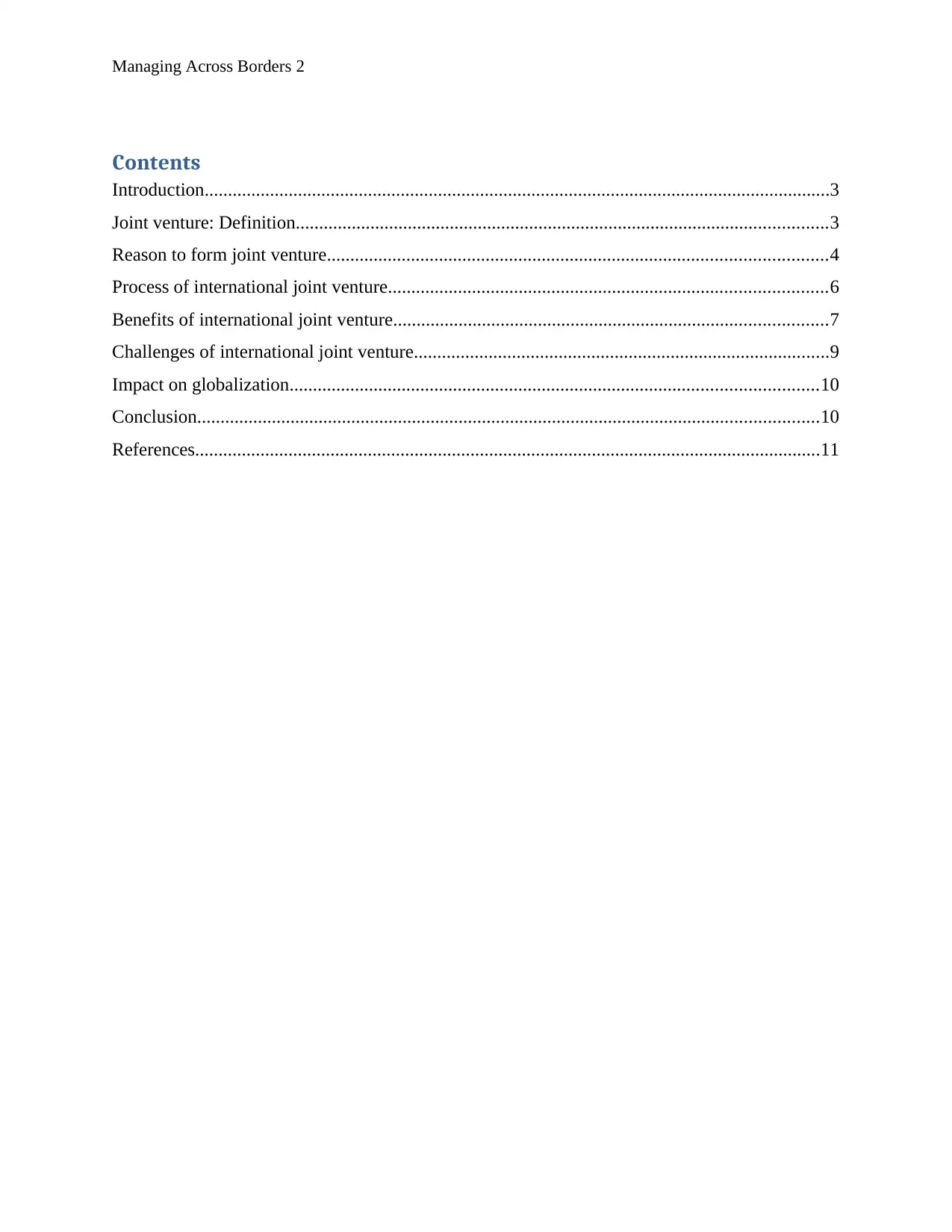
Managing Across Borders 2
Contents
Introduction......................................................................................................................................3
Joint venture: Definition..................................................................................................................3
Reason to form joint venture...........................................................................................................4
Process of international joint venture..............................................................................................6
Benefits of international joint venture.............................................................................................7
Challenges of international joint venture.........................................................................................9
Impact on globalization.................................................................................................................10
Conclusion.....................................................................................................................................10
References......................................................................................................................................11
Contents
Introduction......................................................................................................................................3
Joint venture: Definition..................................................................................................................3
Reason to form joint venture...........................................................................................................4
Process of international joint venture..............................................................................................6
Benefits of international joint venture.............................................................................................7
Challenges of international joint venture.........................................................................................9
Impact on globalization.................................................................................................................10
Conclusion.....................................................................................................................................10
References......................................................................................................................................11
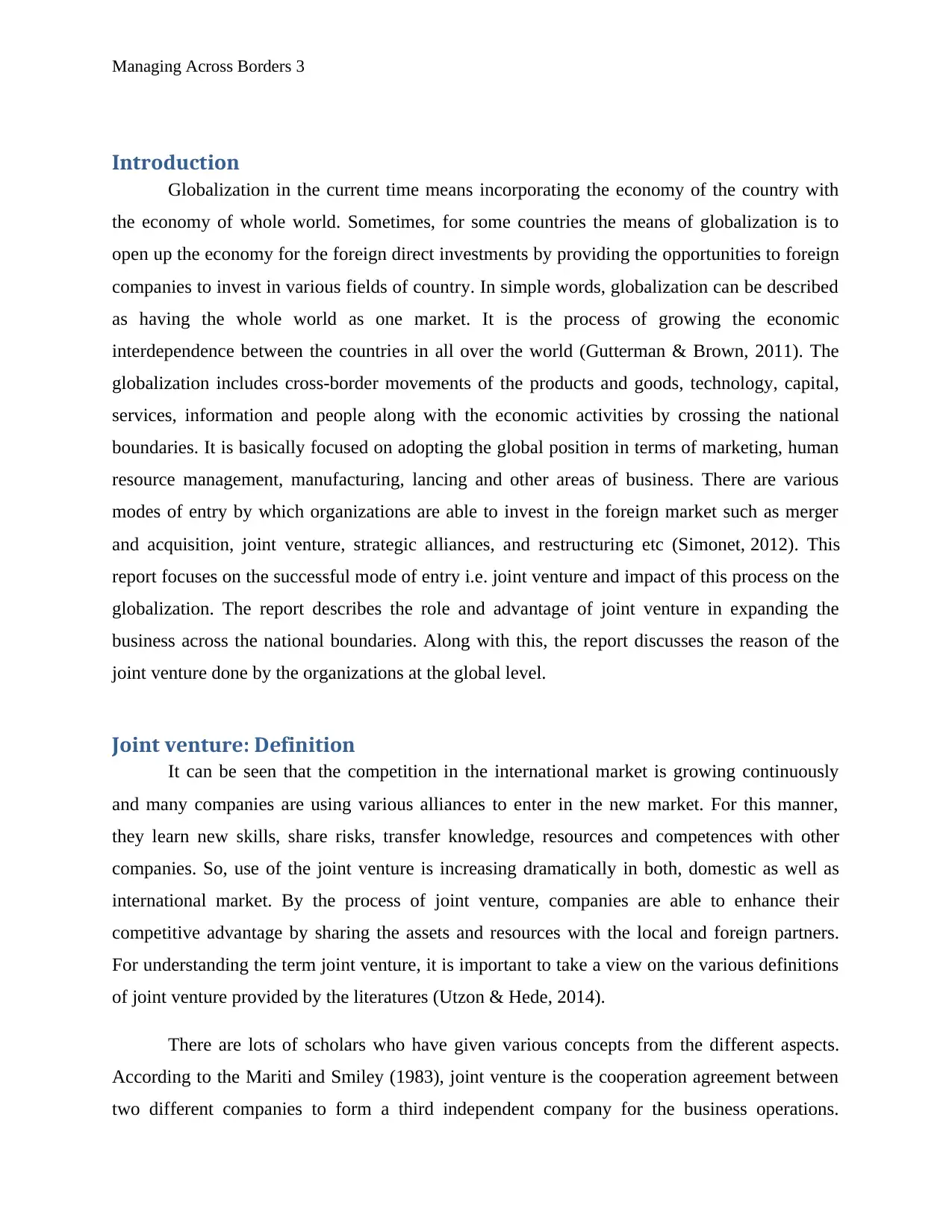
Managing Across Borders 3
Introduction
Globalization in the current time means incorporating the economy of the country with
the economy of whole world. Sometimes, for some countries the means of globalization is to
open up the economy for the foreign direct investments by providing the opportunities to foreign
companies to invest in various fields of country. In simple words, globalization can be described
as having the whole world as one market. It is the process of growing the economic
interdependence between the countries in all over the world (Gutterman & Brown, 2011). The
globalization includes cross-border movements of the products and goods, technology, capital,
services, information and people along with the economic activities by crossing the national
boundaries. It is basically focused on adopting the global position in terms of marketing, human
resource management, manufacturing, lancing and other areas of business. There are various
modes of entry by which organizations are able to invest in the foreign market such as merger
and acquisition, joint venture, strategic alliances, and restructuring etc (Simonet, 2012). This
report focuses on the successful mode of entry i.e. joint venture and impact of this process on the
globalization. The report describes the role and advantage of joint venture in expanding the
business across the national boundaries. Along with this, the report discusses the reason of the
joint venture done by the organizations at the global level.
Joint venture: Definition
It can be seen that the competition in the international market is growing continuously
and many companies are using various alliances to enter in the new market. For this manner,
they learn new skills, share risks, transfer knowledge, resources and competences with other
companies. So, use of the joint venture is increasing dramatically in both, domestic as well as
international market. By the process of joint venture, companies are able to enhance their
competitive advantage by sharing the assets and resources with the local and foreign partners.
For understanding the term joint venture, it is important to take a view on the various definitions
of joint venture provided by the literatures (Utzon & Hede, 2014).
There are lots of scholars who have given various concepts from the different aspects.
According to the Mariti and Smiley (1983), joint venture is the cooperation agreement between
two different companies to form a third independent company for the business operations.
Introduction
Globalization in the current time means incorporating the economy of the country with
the economy of whole world. Sometimes, for some countries the means of globalization is to
open up the economy for the foreign direct investments by providing the opportunities to foreign
companies to invest in various fields of country. In simple words, globalization can be described
as having the whole world as one market. It is the process of growing the economic
interdependence between the countries in all over the world (Gutterman & Brown, 2011). The
globalization includes cross-border movements of the products and goods, technology, capital,
services, information and people along with the economic activities by crossing the national
boundaries. It is basically focused on adopting the global position in terms of marketing, human
resource management, manufacturing, lancing and other areas of business. There are various
modes of entry by which organizations are able to invest in the foreign market such as merger
and acquisition, joint venture, strategic alliances, and restructuring etc (Simonet, 2012). This
report focuses on the successful mode of entry i.e. joint venture and impact of this process on the
globalization. The report describes the role and advantage of joint venture in expanding the
business across the national boundaries. Along with this, the report discusses the reason of the
joint venture done by the organizations at the global level.
Joint venture: Definition
It can be seen that the competition in the international market is growing continuously
and many companies are using various alliances to enter in the new market. For this manner,
they learn new skills, share risks, transfer knowledge, resources and competences with other
companies. So, use of the joint venture is increasing dramatically in both, domestic as well as
international market. By the process of joint venture, companies are able to enhance their
competitive advantage by sharing the assets and resources with the local and foreign partners.
For understanding the term joint venture, it is important to take a view on the various definitions
of joint venture provided by the literatures (Utzon & Hede, 2014).
There are lots of scholars who have given various concepts from the different aspects.
According to the Mariti and Smiley (1983), joint venture is the cooperation agreement between
two different companies to form a third independent company for the business operations.
⊘ This is a preview!⊘
Do you want full access?
Subscribe today to unlock all pages.

Trusted by 1+ million students worldwide
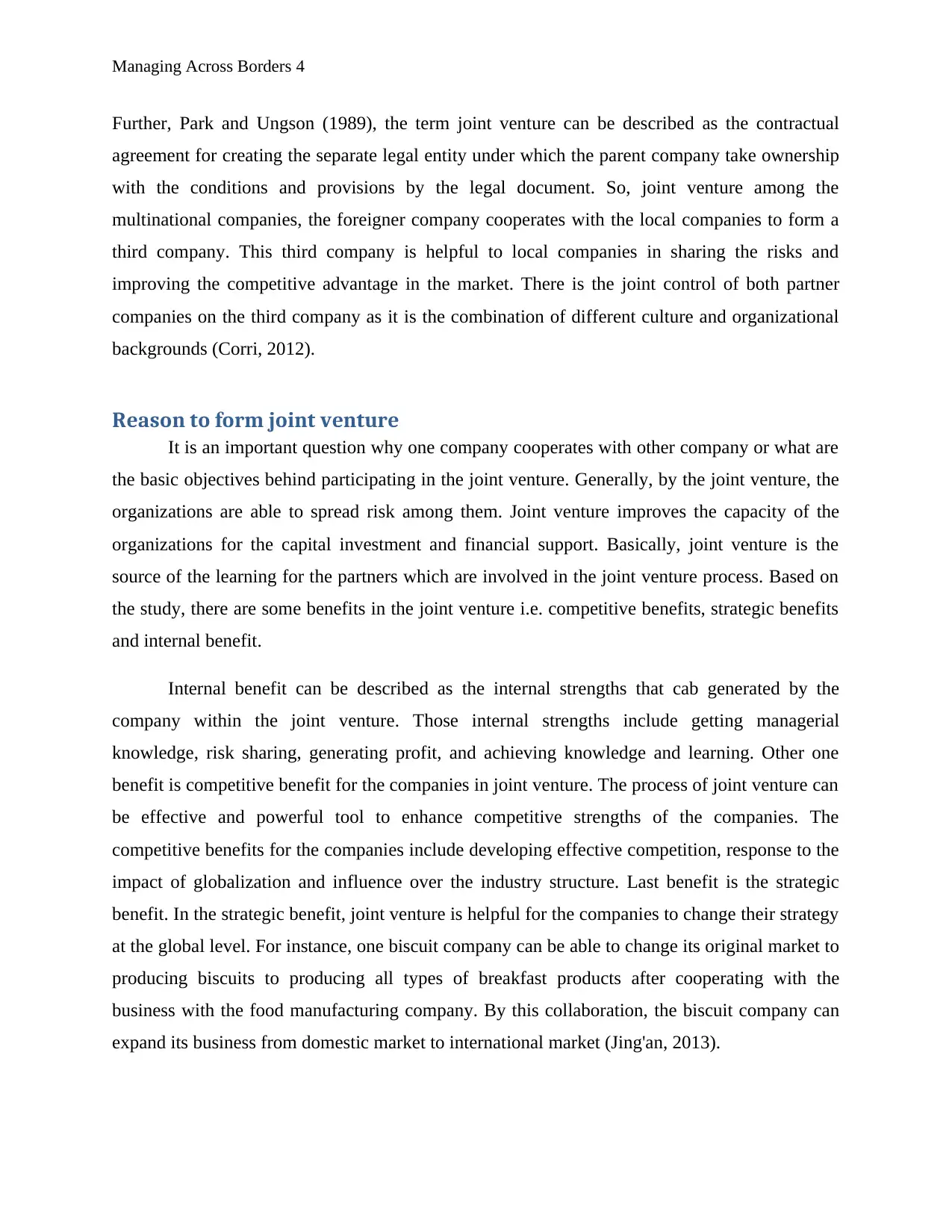
Managing Across Borders 4
Further, Park and Ungson (1989), the term joint venture can be described as the contractual
agreement for creating the separate legal entity under which the parent company take ownership
with the conditions and provisions by the legal document. So, joint venture among the
multinational companies, the foreigner company cooperates with the local companies to form a
third company. This third company is helpful to local companies in sharing the risks and
improving the competitive advantage in the market. There is the joint control of both partner
companies on the third company as it is the combination of different culture and organizational
backgrounds (Corri, 2012).
Reason to form joint venture
It is an important question why one company cooperates with other company or what are
the basic objectives behind participating in the joint venture. Generally, by the joint venture, the
organizations are able to spread risk among them. Joint venture improves the capacity of the
organizations for the capital investment and financial support. Basically, joint venture is the
source of the learning for the partners which are involved in the joint venture process. Based on
the study, there are some benefits in the joint venture i.e. competitive benefits, strategic benefits
and internal benefit.
Internal benefit can be described as the internal strengths that cab generated by the
company within the joint venture. Those internal strengths include getting managerial
knowledge, risk sharing, generating profit, and achieving knowledge and learning. Other one
benefit is competitive benefit for the companies in joint venture. The process of joint venture can
be effective and powerful tool to enhance competitive strengths of the companies. The
competitive benefits for the companies include developing effective competition, response to the
impact of globalization and influence over the industry structure. Last benefit is the strategic
benefit. In the strategic benefit, joint venture is helpful for the companies to change their strategy
at the global level. For instance, one biscuit company can be able to change its original market to
producing biscuits to producing all types of breakfast products after cooperating with the
business with the food manufacturing company. By this collaboration, the biscuit company can
expand its business from domestic market to international market (Jing'an, 2013).
Further, Park and Ungson (1989), the term joint venture can be described as the contractual
agreement for creating the separate legal entity under which the parent company take ownership
with the conditions and provisions by the legal document. So, joint venture among the
multinational companies, the foreigner company cooperates with the local companies to form a
third company. This third company is helpful to local companies in sharing the risks and
improving the competitive advantage in the market. There is the joint control of both partner
companies on the third company as it is the combination of different culture and organizational
backgrounds (Corri, 2012).
Reason to form joint venture
It is an important question why one company cooperates with other company or what are
the basic objectives behind participating in the joint venture. Generally, by the joint venture, the
organizations are able to spread risk among them. Joint venture improves the capacity of the
organizations for the capital investment and financial support. Basically, joint venture is the
source of the learning for the partners which are involved in the joint venture process. Based on
the study, there are some benefits in the joint venture i.e. competitive benefits, strategic benefits
and internal benefit.
Internal benefit can be described as the internal strengths that cab generated by the
company within the joint venture. Those internal strengths include getting managerial
knowledge, risk sharing, generating profit, and achieving knowledge and learning. Other one
benefit is competitive benefit for the companies in joint venture. The process of joint venture can
be effective and powerful tool to enhance competitive strengths of the companies. The
competitive benefits for the companies include developing effective competition, response to the
impact of globalization and influence over the industry structure. Last benefit is the strategic
benefit. In the strategic benefit, joint venture is helpful for the companies to change their strategy
at the global level. For instance, one biscuit company can be able to change its original market to
producing biscuits to producing all types of breakfast products after cooperating with the
business with the food manufacturing company. By this collaboration, the biscuit company can
expand its business from domestic market to international market (Jing'an, 2013).
Paraphrase This Document
Need a fresh take? Get an instant paraphrase of this document with our AI Paraphraser
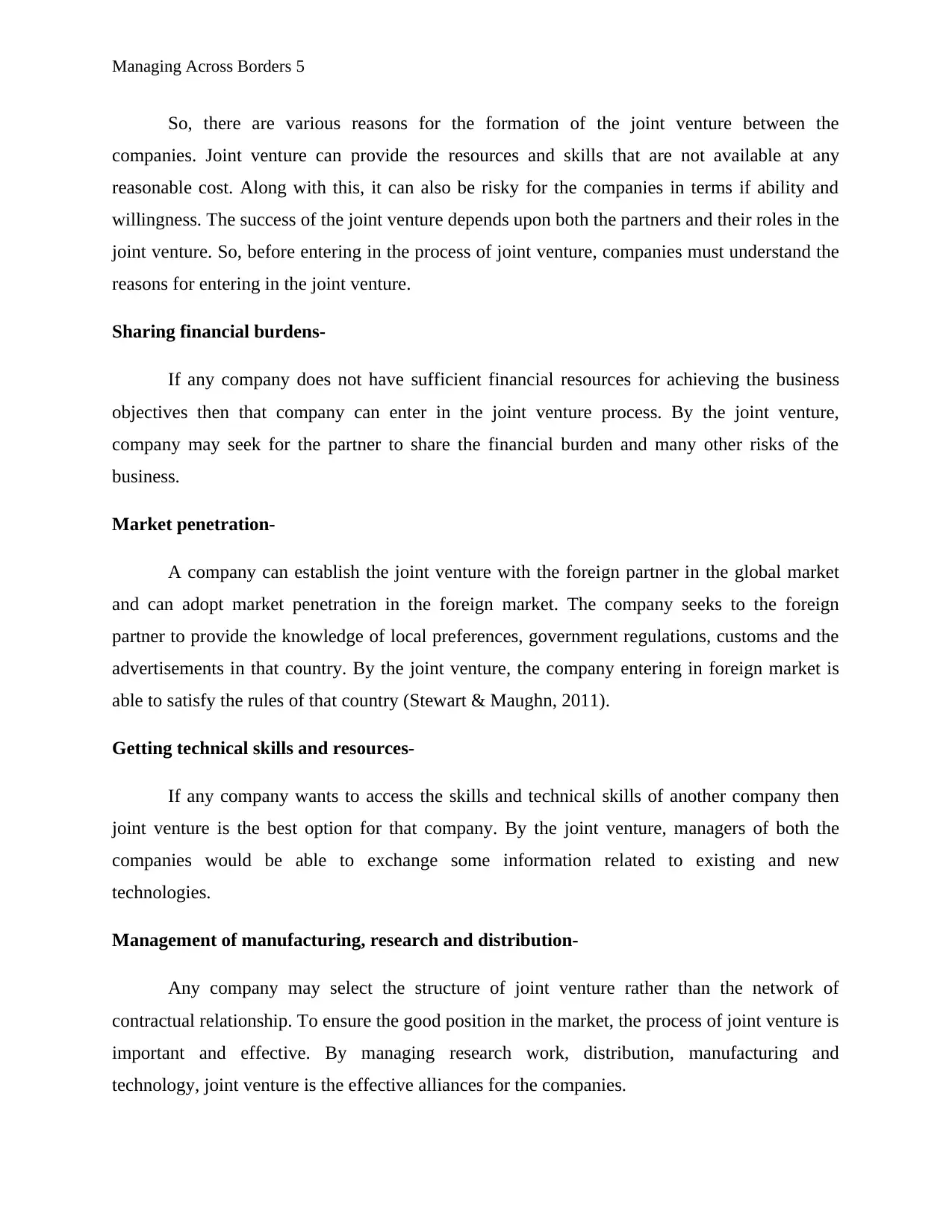
Managing Across Borders 5
So, there are various reasons for the formation of the joint venture between the
companies. Joint venture can provide the resources and skills that are not available at any
reasonable cost. Along with this, it can also be risky for the companies in terms if ability and
willingness. The success of the joint venture depends upon both the partners and their roles in the
joint venture. So, before entering in the process of joint venture, companies must understand the
reasons for entering in the joint venture.
Sharing financial burdens-
If any company does not have sufficient financial resources for achieving the business
objectives then that company can enter in the joint venture process. By the joint venture,
company may seek for the partner to share the financial burden and many other risks of the
business.
Market penetration-
A company can establish the joint venture with the foreign partner in the global market
and can adopt market penetration in the foreign market. The company seeks to the foreign
partner to provide the knowledge of local preferences, government regulations, customs and the
advertisements in that country. By the joint venture, the company entering in foreign market is
able to satisfy the rules of that country (Stewart & Maughn, 2011).
Getting technical skills and resources-
If any company wants to access the skills and technical skills of another company then
joint venture is the best option for that company. By the joint venture, managers of both the
companies would be able to exchange some information related to existing and new
technologies.
Management of manufacturing, research and distribution-
Any company may select the structure of joint venture rather than the network of
contractual relationship. To ensure the good position in the market, the process of joint venture is
important and effective. By managing research work, distribution, manufacturing and
technology, joint venture is the effective alliances for the companies.
So, there are various reasons for the formation of the joint venture between the
companies. Joint venture can provide the resources and skills that are not available at any
reasonable cost. Along with this, it can also be risky for the companies in terms if ability and
willingness. The success of the joint venture depends upon both the partners and their roles in the
joint venture. So, before entering in the process of joint venture, companies must understand the
reasons for entering in the joint venture.
Sharing financial burdens-
If any company does not have sufficient financial resources for achieving the business
objectives then that company can enter in the joint venture process. By the joint venture,
company may seek for the partner to share the financial burden and many other risks of the
business.
Market penetration-
A company can establish the joint venture with the foreign partner in the global market
and can adopt market penetration in the foreign market. The company seeks to the foreign
partner to provide the knowledge of local preferences, government regulations, customs and the
advertisements in that country. By the joint venture, the company entering in foreign market is
able to satisfy the rules of that country (Stewart & Maughn, 2011).
Getting technical skills and resources-
If any company wants to access the skills and technical skills of another company then
joint venture is the best option for that company. By the joint venture, managers of both the
companies would be able to exchange some information related to existing and new
technologies.
Management of manufacturing, research and distribution-
Any company may select the structure of joint venture rather than the network of
contractual relationship. To ensure the good position in the market, the process of joint venture is
important and effective. By managing research work, distribution, manufacturing and
technology, joint venture is the effective alliances for the companies.
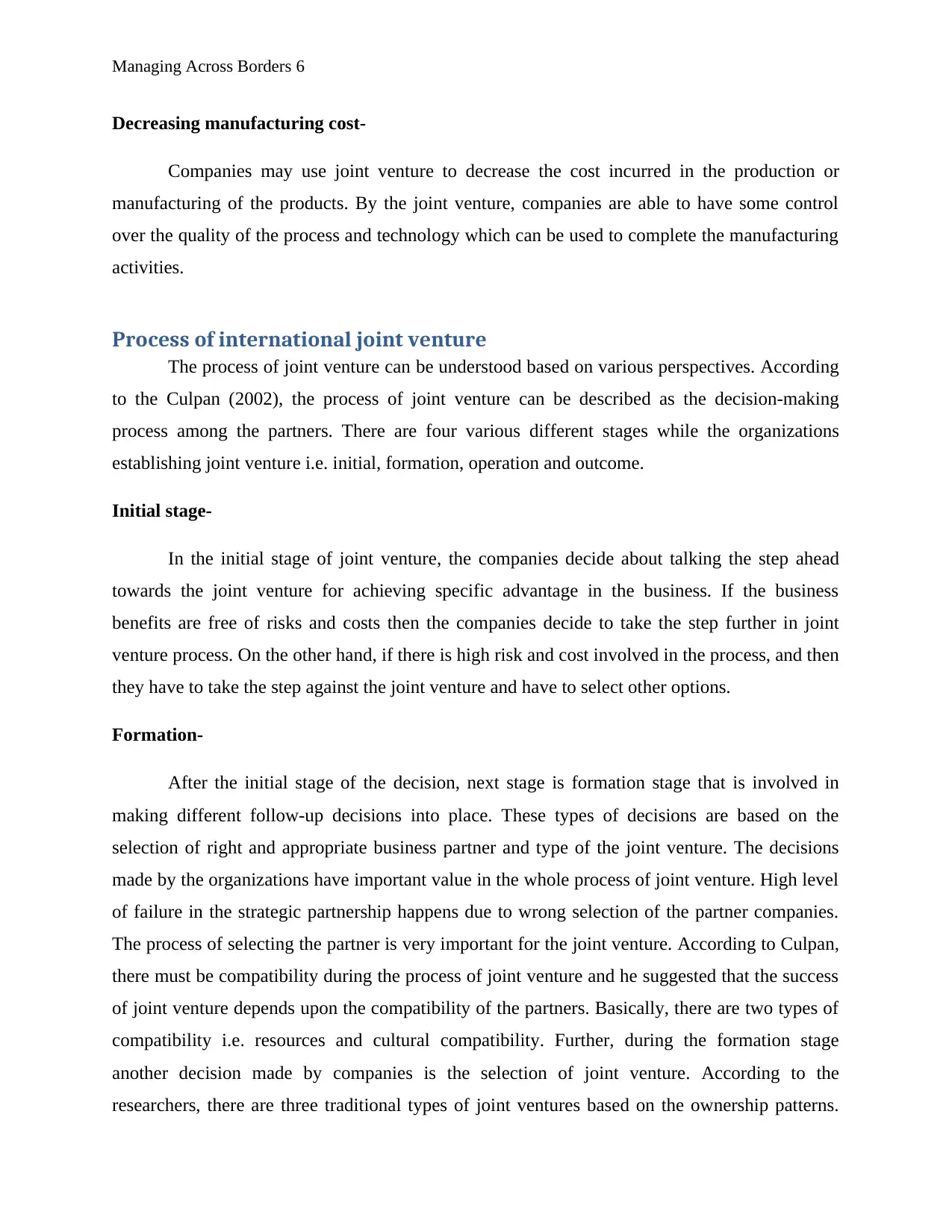
Managing Across Borders 6
Decreasing manufacturing cost-
Companies may use joint venture to decrease the cost incurred in the production or
manufacturing of the products. By the joint venture, companies are able to have some control
over the quality of the process and technology which can be used to complete the manufacturing
activities.
Process of international joint venture
The process of joint venture can be understood based on various perspectives. According
to the Culpan (2002), the process of joint venture can be described as the decision-making
process among the partners. There are four various different stages while the organizations
establishing joint venture i.e. initial, formation, operation and outcome.
Initial stage-
In the initial stage of joint venture, the companies decide about talking the step ahead
towards the joint venture for achieving specific advantage in the business. If the business
benefits are free of risks and costs then the companies decide to take the step further in joint
venture process. On the other hand, if there is high risk and cost involved in the process, and then
they have to take the step against the joint venture and have to select other options.
Formation-
After the initial stage of the decision, next stage is formation stage that is involved in
making different follow-up decisions into place. These types of decisions are based on the
selection of right and appropriate business partner and type of the joint venture. The decisions
made by the organizations have important value in the whole process of joint venture. High level
of failure in the strategic partnership happens due to wrong selection of the partner companies.
The process of selecting the partner is very important for the joint venture. According to Culpan,
there must be compatibility during the process of joint venture and he suggested that the success
of joint venture depends upon the compatibility of the partners. Basically, there are two types of
compatibility i.e. resources and cultural compatibility. Further, during the formation stage
another decision made by companies is the selection of joint venture. According to the
researchers, there are three traditional types of joint ventures based on the ownership patterns.
Decreasing manufacturing cost-
Companies may use joint venture to decrease the cost incurred in the production or
manufacturing of the products. By the joint venture, companies are able to have some control
over the quality of the process and technology which can be used to complete the manufacturing
activities.
Process of international joint venture
The process of joint venture can be understood based on various perspectives. According
to the Culpan (2002), the process of joint venture can be described as the decision-making
process among the partners. There are four various different stages while the organizations
establishing joint venture i.e. initial, formation, operation and outcome.
Initial stage-
In the initial stage of joint venture, the companies decide about talking the step ahead
towards the joint venture for achieving specific advantage in the business. If the business
benefits are free of risks and costs then the companies decide to take the step further in joint
venture process. On the other hand, if there is high risk and cost involved in the process, and then
they have to take the step against the joint venture and have to select other options.
Formation-
After the initial stage of the decision, next stage is formation stage that is involved in
making different follow-up decisions into place. These types of decisions are based on the
selection of right and appropriate business partner and type of the joint venture. The decisions
made by the organizations have important value in the whole process of joint venture. High level
of failure in the strategic partnership happens due to wrong selection of the partner companies.
The process of selecting the partner is very important for the joint venture. According to Culpan,
there must be compatibility during the process of joint venture and he suggested that the success
of joint venture depends upon the compatibility of the partners. Basically, there are two types of
compatibility i.e. resources and cultural compatibility. Further, during the formation stage
another decision made by companies is the selection of joint venture. According to the
researchers, there are three traditional types of joint ventures based on the ownership patterns.
⊘ This is a preview!⊘
Do you want full access?
Subscribe today to unlock all pages.

Trusted by 1+ million students worldwide
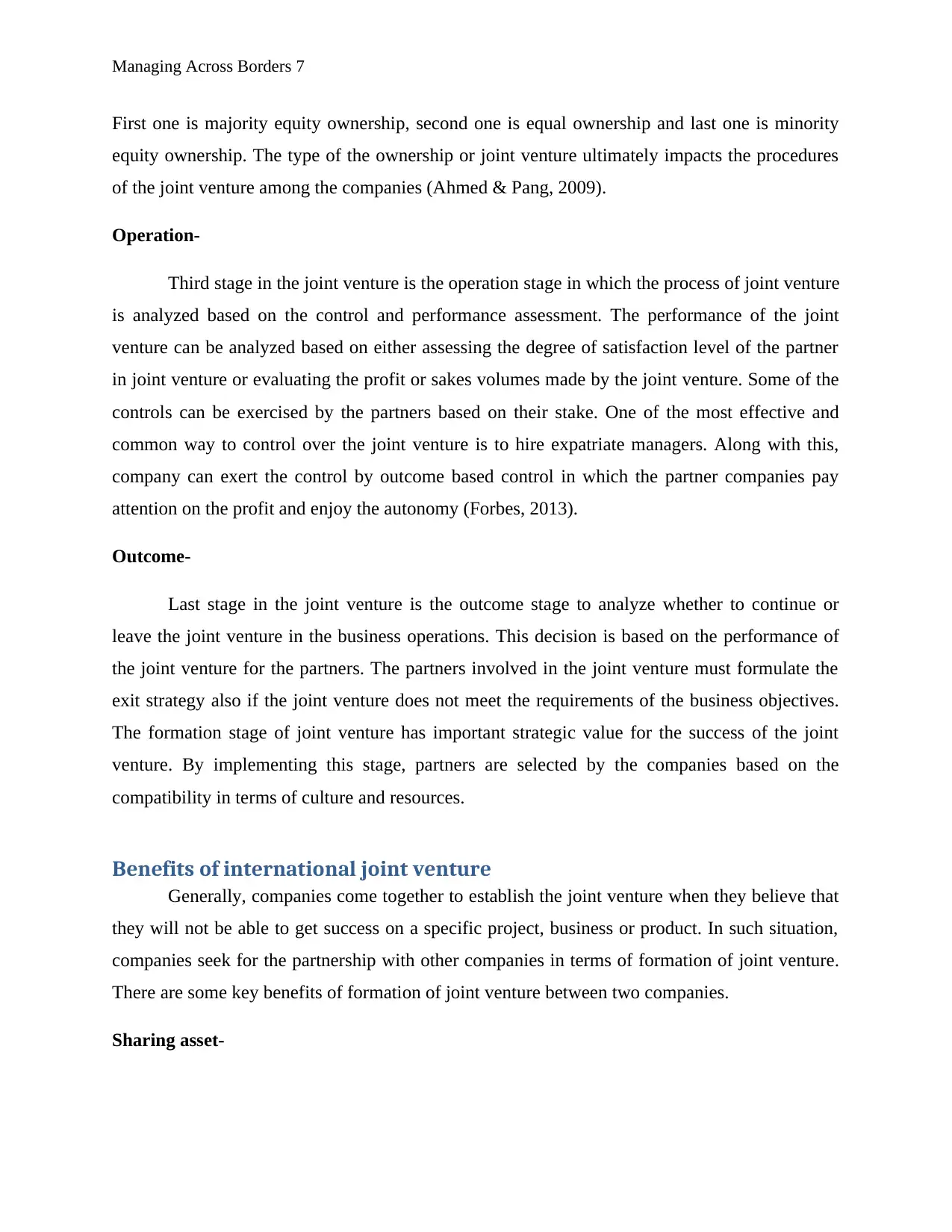
Managing Across Borders 7
First one is majority equity ownership, second one is equal ownership and last one is minority
equity ownership. The type of the ownership or joint venture ultimately impacts the procedures
of the joint venture among the companies (Ahmed & Pang, 2009).
Operation-
Third stage in the joint venture is the operation stage in which the process of joint venture
is analyzed based on the control and performance assessment. The performance of the joint
venture can be analyzed based on either assessing the degree of satisfaction level of the partner
in joint venture or evaluating the profit or sakes volumes made by the joint venture. Some of the
controls can be exercised by the partners based on their stake. One of the most effective and
common way to control over the joint venture is to hire expatriate managers. Along with this,
company can exert the control by outcome based control in which the partner companies pay
attention on the profit and enjoy the autonomy (Forbes, 2013).
Outcome-
Last stage in the joint venture is the outcome stage to analyze whether to continue or
leave the joint venture in the business operations. This decision is based on the performance of
the joint venture for the partners. The partners involved in the joint venture must formulate the
exit strategy also if the joint venture does not meet the requirements of the business objectives.
The formation stage of joint venture has important strategic value for the success of the joint
venture. By implementing this stage, partners are selected by the companies based on the
compatibility in terms of culture and resources.
Benefits of international joint venture
Generally, companies come together to establish the joint venture when they believe that
they will not be able to get success on a specific project, business or product. In such situation,
companies seek for the partnership with other companies in terms of formation of joint venture.
There are some key benefits of formation of joint venture between two companies.
Sharing asset-
First one is majority equity ownership, second one is equal ownership and last one is minority
equity ownership. The type of the ownership or joint venture ultimately impacts the procedures
of the joint venture among the companies (Ahmed & Pang, 2009).
Operation-
Third stage in the joint venture is the operation stage in which the process of joint venture
is analyzed based on the control and performance assessment. The performance of the joint
venture can be analyzed based on either assessing the degree of satisfaction level of the partner
in joint venture or evaluating the profit or sakes volumes made by the joint venture. Some of the
controls can be exercised by the partners based on their stake. One of the most effective and
common way to control over the joint venture is to hire expatriate managers. Along with this,
company can exert the control by outcome based control in which the partner companies pay
attention on the profit and enjoy the autonomy (Forbes, 2013).
Outcome-
Last stage in the joint venture is the outcome stage to analyze whether to continue or
leave the joint venture in the business operations. This decision is based on the performance of
the joint venture for the partners. The partners involved in the joint venture must formulate the
exit strategy also if the joint venture does not meet the requirements of the business objectives.
The formation stage of joint venture has important strategic value for the success of the joint
venture. By implementing this stage, partners are selected by the companies based on the
compatibility in terms of culture and resources.
Benefits of international joint venture
Generally, companies come together to establish the joint venture when they believe that
they will not be able to get success on a specific project, business or product. In such situation,
companies seek for the partnership with other companies in terms of formation of joint venture.
There are some key benefits of formation of joint venture between two companies.
Sharing asset-
Paraphrase This Document
Need a fresh take? Get an instant paraphrase of this document with our AI Paraphraser
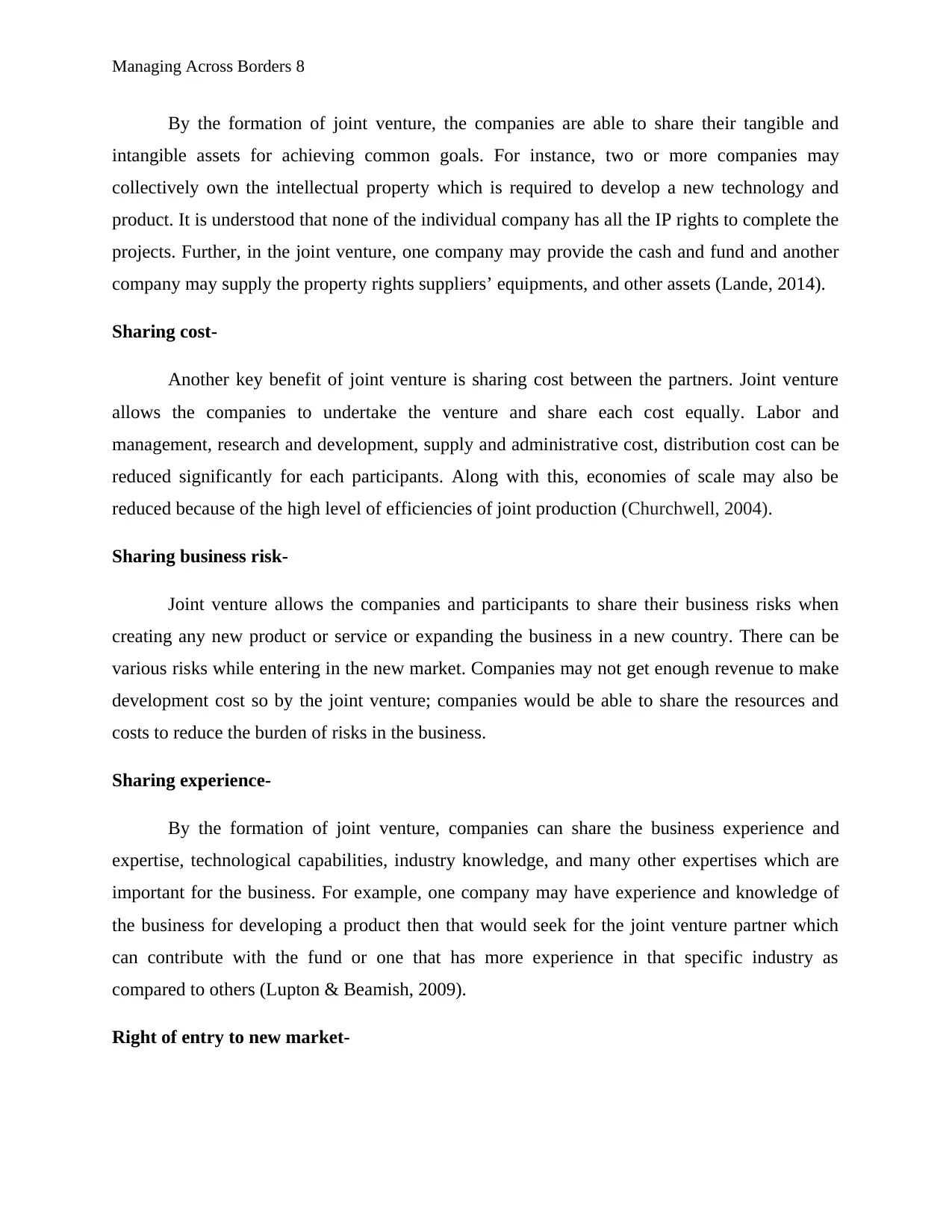
Managing Across Borders 8
By the formation of joint venture, the companies are able to share their tangible and
intangible assets for achieving common goals. For instance, two or more companies may
collectively own the intellectual property which is required to develop a new technology and
product. It is understood that none of the individual company has all the IP rights to complete the
projects. Further, in the joint venture, one company may provide the cash and fund and another
company may supply the property rights suppliers’ equipments, and other assets (Lande, 2014).
Sharing cost-
Another key benefit of joint venture is sharing cost between the partners. Joint venture
allows the companies to undertake the venture and share each cost equally. Labor and
management, research and development, supply and administrative cost, distribution cost can be
reduced significantly for each participants. Along with this, economies of scale may also be
reduced because of the high level of efficiencies of joint production (Churchwell, 2004).
Sharing business risk-
Joint venture allows the companies and participants to share their business risks when
creating any new product or service or expanding the business in a new country. There can be
various risks while entering in the new market. Companies may not get enough revenue to make
development cost so by the joint venture; companies would be able to share the resources and
costs to reduce the burden of risks in the business.
Sharing experience-
By the formation of joint venture, companies can share the business experience and
expertise, technological capabilities, industry knowledge, and many other expertises which are
important for the business. For example, one company may have experience and knowledge of
the business for developing a product then that would seek for the joint venture partner which
can contribute with the fund or one that has more experience in that specific industry as
compared to others (Lupton & Beamish, 2009).
Right of entry to new market-
By the formation of joint venture, the companies are able to share their tangible and
intangible assets for achieving common goals. For instance, two or more companies may
collectively own the intellectual property which is required to develop a new technology and
product. It is understood that none of the individual company has all the IP rights to complete the
projects. Further, in the joint venture, one company may provide the cash and fund and another
company may supply the property rights suppliers’ equipments, and other assets (Lande, 2014).
Sharing cost-
Another key benefit of joint venture is sharing cost between the partners. Joint venture
allows the companies to undertake the venture and share each cost equally. Labor and
management, research and development, supply and administrative cost, distribution cost can be
reduced significantly for each participants. Along with this, economies of scale may also be
reduced because of the high level of efficiencies of joint production (Churchwell, 2004).
Sharing business risk-
Joint venture allows the companies and participants to share their business risks when
creating any new product or service or expanding the business in a new country. There can be
various risks while entering in the new market. Companies may not get enough revenue to make
development cost so by the joint venture; companies would be able to share the resources and
costs to reduce the burden of risks in the business.
Sharing experience-
By the formation of joint venture, companies can share the business experience and
expertise, technological capabilities, industry knowledge, and many other expertises which are
important for the business. For example, one company may have experience and knowledge of
the business for developing a product then that would seek for the joint venture partner which
can contribute with the fund or one that has more experience in that specific industry as
compared to others (Lupton & Beamish, 2009).
Right of entry to new market-
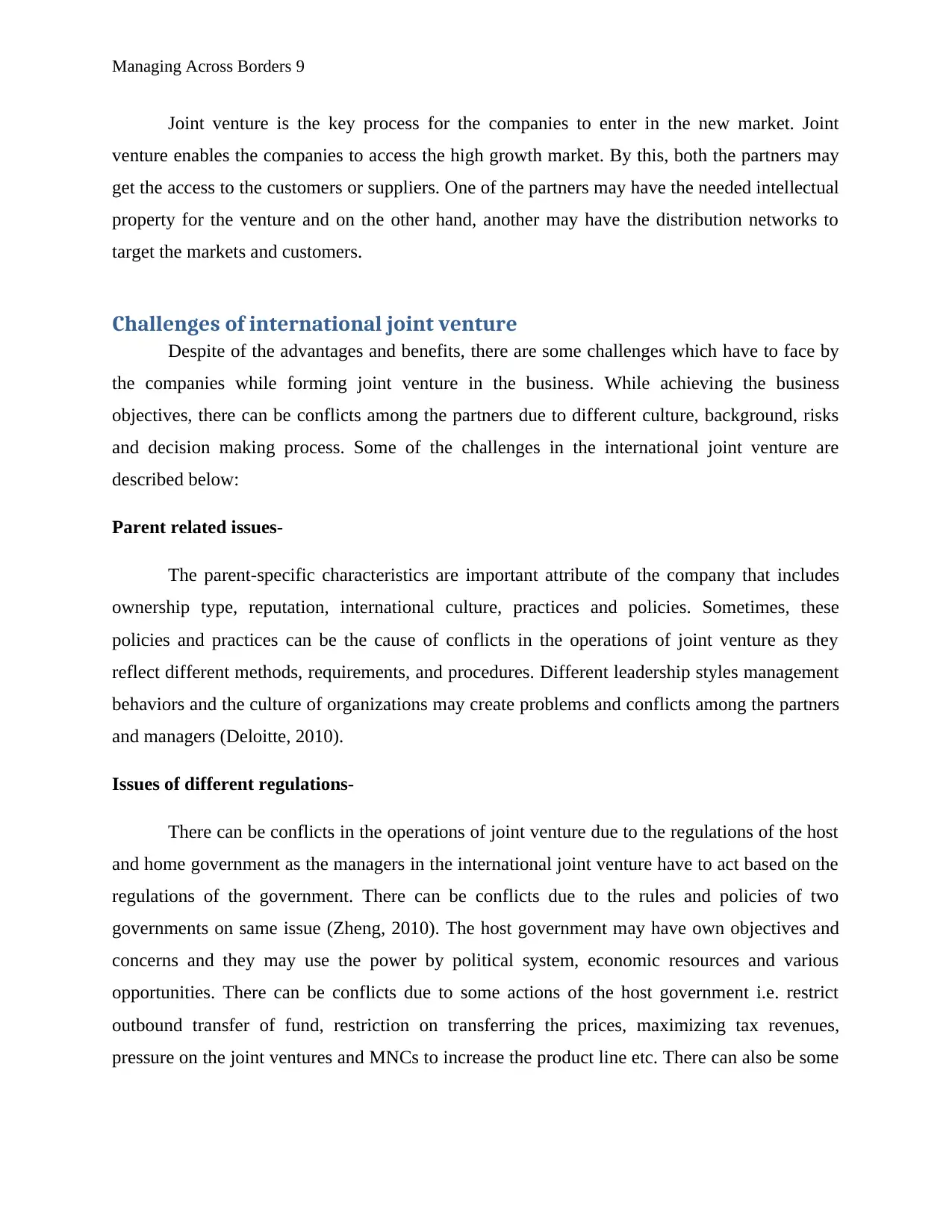
Managing Across Borders 9
Joint venture is the key process for the companies to enter in the new market. Joint
venture enables the companies to access the high growth market. By this, both the partners may
get the access to the customers or suppliers. One of the partners may have the needed intellectual
property for the venture and on the other hand, another may have the distribution networks to
target the markets and customers.
Challenges of international joint venture
Despite of the advantages and benefits, there are some challenges which have to face by
the companies while forming joint venture in the business. While achieving the business
objectives, there can be conflicts among the partners due to different culture, background, risks
and decision making process. Some of the challenges in the international joint venture are
described below:
Parent related issues-
The parent-specific characteristics are important attribute of the company that includes
ownership type, reputation, international culture, practices and policies. Sometimes, these
policies and practices can be the cause of conflicts in the operations of joint venture as they
reflect different methods, requirements, and procedures. Different leadership styles management
behaviors and the culture of organizations may create problems and conflicts among the partners
and managers (Deloitte, 2010).
Issues of different regulations-
There can be conflicts in the operations of joint venture due to the regulations of the host
and home government as the managers in the international joint venture have to act based on the
regulations of the government. There can be conflicts due to the rules and policies of two
governments on same issue (Zheng, 2010). The host government may have own objectives and
concerns and they may use the power by political system, economic resources and various
opportunities. There can be conflicts due to some actions of the host government i.e. restrict
outbound transfer of fund, restriction on transferring the prices, maximizing tax revenues,
pressure on the joint ventures and MNCs to increase the product line etc. There can also be some
Joint venture is the key process for the companies to enter in the new market. Joint
venture enables the companies to access the high growth market. By this, both the partners may
get the access to the customers or suppliers. One of the partners may have the needed intellectual
property for the venture and on the other hand, another may have the distribution networks to
target the markets and customers.
Challenges of international joint venture
Despite of the advantages and benefits, there are some challenges which have to face by
the companies while forming joint venture in the business. While achieving the business
objectives, there can be conflicts among the partners due to different culture, background, risks
and decision making process. Some of the challenges in the international joint venture are
described below:
Parent related issues-
The parent-specific characteristics are important attribute of the company that includes
ownership type, reputation, international culture, practices and policies. Sometimes, these
policies and practices can be the cause of conflicts in the operations of joint venture as they
reflect different methods, requirements, and procedures. Different leadership styles management
behaviors and the culture of organizations may create problems and conflicts among the partners
and managers (Deloitte, 2010).
Issues of different regulations-
There can be conflicts in the operations of joint venture due to the regulations of the host
and home government as the managers in the international joint venture have to act based on the
regulations of the government. There can be conflicts due to the rules and policies of two
governments on same issue (Zheng, 2010). The host government may have own objectives and
concerns and they may use the power by political system, economic resources and various
opportunities. There can be conflicts due to some actions of the host government i.e. restrict
outbound transfer of fund, restriction on transferring the prices, maximizing tax revenues,
pressure on the joint ventures and MNCs to increase the product line etc. There can also be some
⊘ This is a preview!⊘
Do you want full access?
Subscribe today to unlock all pages.

Trusted by 1+ million students worldwide
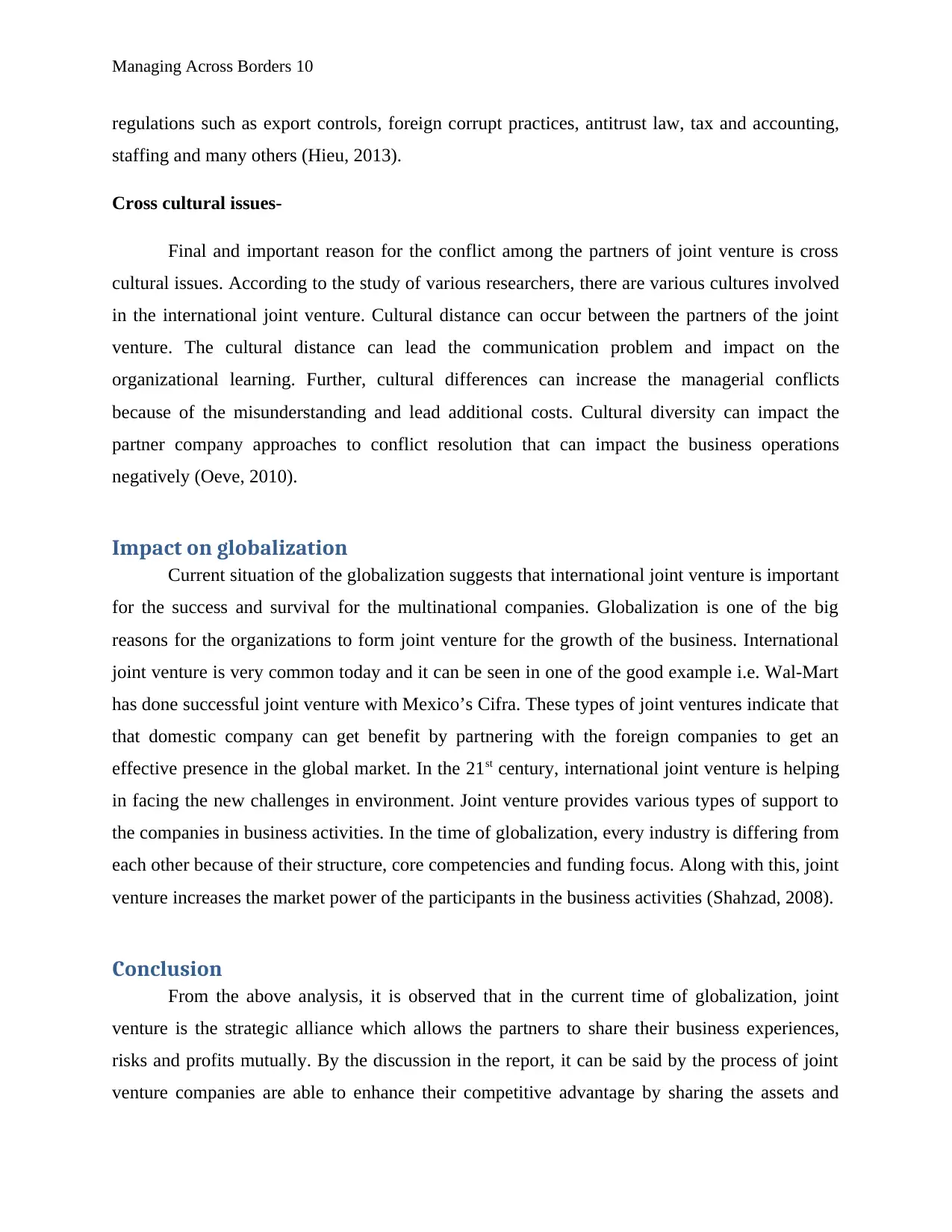
Managing Across Borders 10
regulations such as export controls, foreign corrupt practices, antitrust law, tax and accounting,
staffing and many others (Hieu, 2013).
Cross cultural issues-
Final and important reason for the conflict among the partners of joint venture is cross
cultural issues. According to the study of various researchers, there are various cultures involved
in the international joint venture. Cultural distance can occur between the partners of the joint
venture. The cultural distance can lead the communication problem and impact on the
organizational learning. Further, cultural differences can increase the managerial conflicts
because of the misunderstanding and lead additional costs. Cultural diversity can impact the
partner company approaches to conflict resolution that can impact the business operations
negatively (Oeve, 2010).
Impact on globalization
Current situation of the globalization suggests that international joint venture is important
for the success and survival for the multinational companies. Globalization is one of the big
reasons for the organizations to form joint venture for the growth of the business. International
joint venture is very common today and it can be seen in one of the good example i.e. Wal-Mart
has done successful joint venture with Mexico’s Cifra. These types of joint ventures indicate that
that domestic company can get benefit by partnering with the foreign companies to get an
effective presence in the global market. In the 21st century, international joint venture is helping
in facing the new challenges in environment. Joint venture provides various types of support to
the companies in business activities. In the time of globalization, every industry is differing from
each other because of their structure, core competencies and funding focus. Along with this, joint
venture increases the market power of the participants in the business activities (Shahzad, 2008).
Conclusion
From the above analysis, it is observed that in the current time of globalization, joint
venture is the strategic alliance which allows the partners to share their business experiences,
risks and profits mutually. By the discussion in the report, it can be said by the process of joint
venture companies are able to enhance their competitive advantage by sharing the assets and
regulations such as export controls, foreign corrupt practices, antitrust law, tax and accounting,
staffing and many others (Hieu, 2013).
Cross cultural issues-
Final and important reason for the conflict among the partners of joint venture is cross
cultural issues. According to the study of various researchers, there are various cultures involved
in the international joint venture. Cultural distance can occur between the partners of the joint
venture. The cultural distance can lead the communication problem and impact on the
organizational learning. Further, cultural differences can increase the managerial conflicts
because of the misunderstanding and lead additional costs. Cultural diversity can impact the
partner company approaches to conflict resolution that can impact the business operations
negatively (Oeve, 2010).
Impact on globalization
Current situation of the globalization suggests that international joint venture is important
for the success and survival for the multinational companies. Globalization is one of the big
reasons for the organizations to form joint venture for the growth of the business. International
joint venture is very common today and it can be seen in one of the good example i.e. Wal-Mart
has done successful joint venture with Mexico’s Cifra. These types of joint ventures indicate that
that domestic company can get benefit by partnering with the foreign companies to get an
effective presence in the global market. In the 21st century, international joint venture is helping
in facing the new challenges in environment. Joint venture provides various types of support to
the companies in business activities. In the time of globalization, every industry is differing from
each other because of their structure, core competencies and funding focus. Along with this, joint
venture increases the market power of the participants in the business activities (Shahzad, 2008).
Conclusion
From the above analysis, it is observed that in the current time of globalization, joint
venture is the strategic alliance which allows the partners to share their business experiences,
risks and profits mutually. By the discussion in the report, it can be said by the process of joint
venture companies are able to enhance their competitive advantage by sharing the assets and
Paraphrase This Document
Need a fresh take? Get an instant paraphrase of this document with our AI Paraphraser
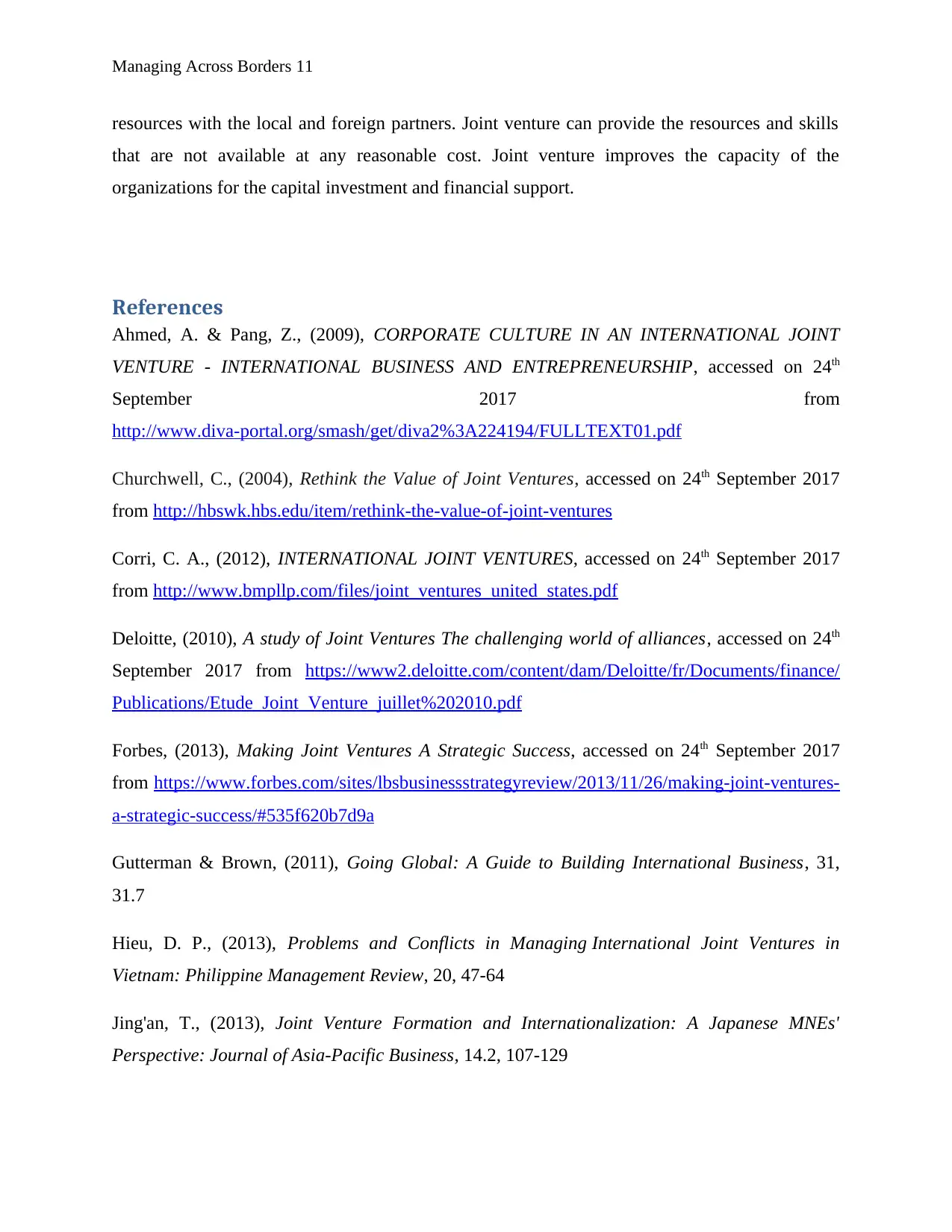
Managing Across Borders 11
resources with the local and foreign partners. Joint venture can provide the resources and skills
that are not available at any reasonable cost. Joint venture improves the capacity of the
organizations for the capital investment and financial support.
References
Ahmed, A. & Pang, Z., (2009), CORPORATE CULTURE IN AN INTERNATIONAL JOINT
VENTURE - INTERNATIONAL BUSINESS AND ENTREPRENEURSHIP, accessed on 24th
September 2017 from
http://www.diva-portal.org/smash/get/diva2%3A224194/FULLTEXT01.pdf
Churchwell, C., (2004), Rethink the Value of Joint Ventures, accessed on 24th September 2017
from http://hbswk.hbs.edu/item/rethink-the-value-of-joint-ventures
Corri, C. A., (2012), INTERNATIONAL JOINT VENTURES, accessed on 24th September 2017
from http://www.bmpllp.com/files/joint_ventures_united_states.pdf
Deloitte, (2010), A study of Joint Ventures The challenging world of alliances, accessed on 24th
September 2017 from https://www2.deloitte.com/content/dam/Deloitte/fr/Documents/finance/
Publications/Etude_Joint_Venture_juillet%202010.pdf
Forbes, (2013), Making Joint Ventures A Strategic Success, accessed on 24th September 2017
from https://www.forbes.com/sites/lbsbusinessstrategyreview/2013/11/26/making-joint-ventures-
a-strategic-success/#535f620b7d9a
Gutterman & Brown, (2011), Going Global: A Guide to Building International Business, 31,
31.7
Hieu, D. P., (2013), Problems and Conflicts in Managing International Joint Ventures in
Vietnam: Philippine Management Review, 20, 47-64
Jing'an, T., (2013), Joint Venture Formation and Internationalization: A Japanese MNEs'
Perspective: Journal of Asia-Pacific Business, 14.2, 107-129
resources with the local and foreign partners. Joint venture can provide the resources and skills
that are not available at any reasonable cost. Joint venture improves the capacity of the
organizations for the capital investment and financial support.
References
Ahmed, A. & Pang, Z., (2009), CORPORATE CULTURE IN AN INTERNATIONAL JOINT
VENTURE - INTERNATIONAL BUSINESS AND ENTREPRENEURSHIP, accessed on 24th
September 2017 from
http://www.diva-portal.org/smash/get/diva2%3A224194/FULLTEXT01.pdf
Churchwell, C., (2004), Rethink the Value of Joint Ventures, accessed on 24th September 2017
from http://hbswk.hbs.edu/item/rethink-the-value-of-joint-ventures
Corri, C. A., (2012), INTERNATIONAL JOINT VENTURES, accessed on 24th September 2017
from http://www.bmpllp.com/files/joint_ventures_united_states.pdf
Deloitte, (2010), A study of Joint Ventures The challenging world of alliances, accessed on 24th
September 2017 from https://www2.deloitte.com/content/dam/Deloitte/fr/Documents/finance/
Publications/Etude_Joint_Venture_juillet%202010.pdf
Forbes, (2013), Making Joint Ventures A Strategic Success, accessed on 24th September 2017
from https://www.forbes.com/sites/lbsbusinessstrategyreview/2013/11/26/making-joint-ventures-
a-strategic-success/#535f620b7d9a
Gutterman & Brown, (2011), Going Global: A Guide to Building International Business, 31,
31.7
Hieu, D. P., (2013), Problems and Conflicts in Managing International Joint Ventures in
Vietnam: Philippine Management Review, 20, 47-64
Jing'an, T., (2013), Joint Venture Formation and Internationalization: A Japanese MNEs'
Perspective: Journal of Asia-Pacific Business, 14.2, 107-129
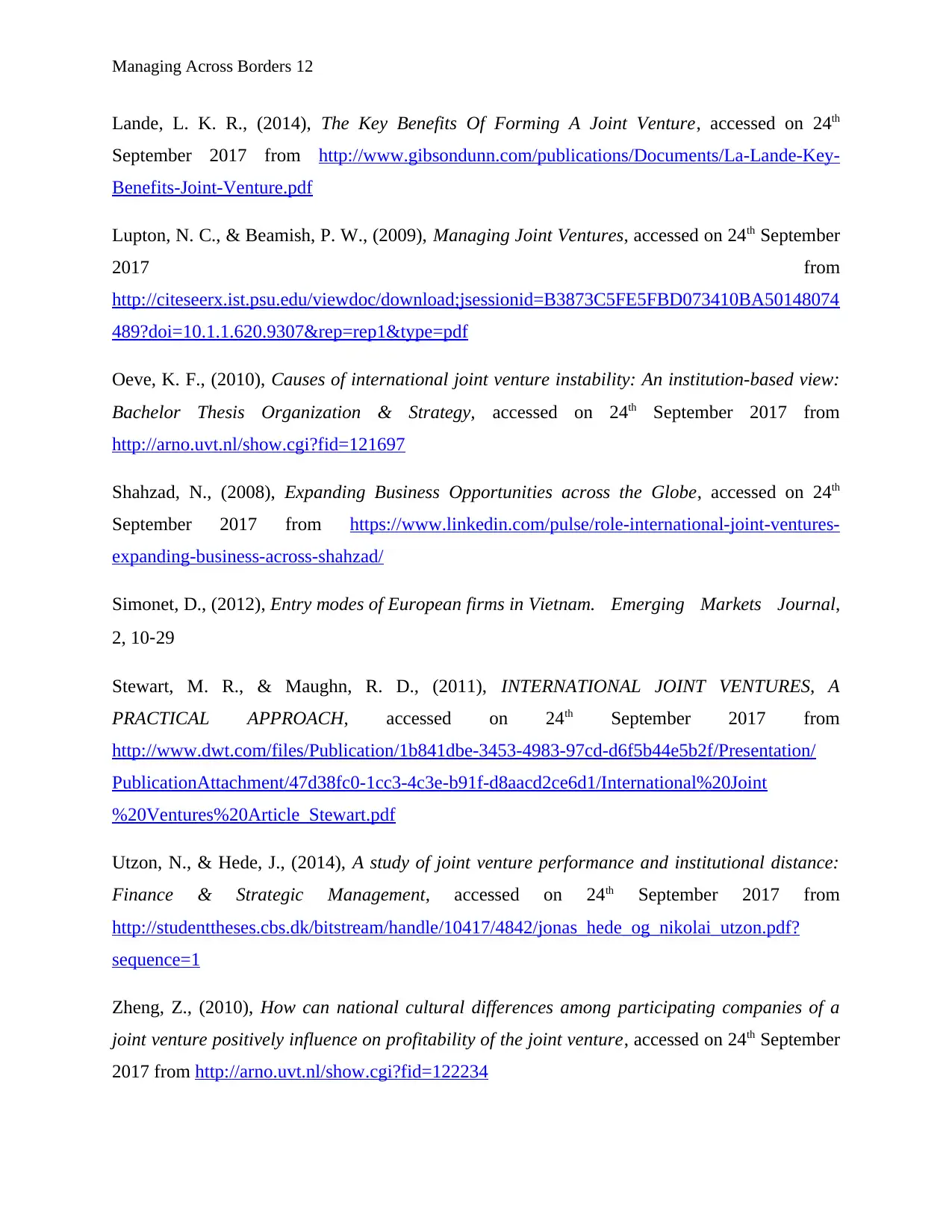
Managing Across Borders 12
Lande, L. K. R., (2014), The Key Benefits Of Forming A Joint Venture, accessed on 24th
September 2017 from http://www.gibsondunn.com/publications/Documents/La-Lande-Key-
Benefits-Joint-Venture.pdf
Lupton, N. C., & Beamish, P. W., (2009), Managing Joint Ventures, accessed on 24th September
2017 from
http://citeseerx.ist.psu.edu/viewdoc/download;jsessionid=B3873C5FE5FBD073410BA50148074
489?doi=10.1.1.620.9307&rep=rep1&type=pdf
Oeve, K. F., (2010), Causes of international joint venture instability: An institution-based view:
Bachelor Thesis Organization & Strategy, accessed on 24th September 2017 from
http://arno.uvt.nl/show.cgi?fid=121697
Shahzad, N., (2008), Expanding Business Opportunities across the Globe, accessed on 24th
September 2017 from https://www.linkedin.com/pulse/role-international-joint-ventures-
expanding-business-across-shahzad/
Simonet, D., (2012), Entry modes of European firms in Vietnam. Emerging Markets Journal,
2, 10‐29
Stewart, M. R., & Maughn, R. D., (2011), INTERNATIONAL JOINT VENTURES, A
PRACTICAL APPROACH, accessed on 24th September 2017 from
http://www.dwt.com/files/Publication/1b841dbe-3453-4983-97cd-d6f5b44e5b2f/Presentation/
PublicationAttachment/47d38fc0-1cc3-4c3e-b91f-d8aacd2ce6d1/International%20Joint
%20Ventures%20Article_Stewart.pdf
Utzon, N., & Hede, J., (2014), A study of joint venture performance and institutional distance:
Finance & Strategic Management, accessed on 24th September 2017 from
http://studenttheses.cbs.dk/bitstream/handle/10417/4842/jonas_hede_og_nikolai_utzon.pdf?
sequence=1
Zheng, Z., (2010), How can national cultural differences among participating companies of a
joint venture positively influence on profitability of the joint venture, accessed on 24th September
2017 from http://arno.uvt.nl/show.cgi?fid=122234
Lande, L. K. R., (2014), The Key Benefits Of Forming A Joint Venture, accessed on 24th
September 2017 from http://www.gibsondunn.com/publications/Documents/La-Lande-Key-
Benefits-Joint-Venture.pdf
Lupton, N. C., & Beamish, P. W., (2009), Managing Joint Ventures, accessed on 24th September
2017 from
http://citeseerx.ist.psu.edu/viewdoc/download;jsessionid=B3873C5FE5FBD073410BA50148074
489?doi=10.1.1.620.9307&rep=rep1&type=pdf
Oeve, K. F., (2010), Causes of international joint venture instability: An institution-based view:
Bachelor Thesis Organization & Strategy, accessed on 24th September 2017 from
http://arno.uvt.nl/show.cgi?fid=121697
Shahzad, N., (2008), Expanding Business Opportunities across the Globe, accessed on 24th
September 2017 from https://www.linkedin.com/pulse/role-international-joint-ventures-
expanding-business-across-shahzad/
Simonet, D., (2012), Entry modes of European firms in Vietnam. Emerging Markets Journal,
2, 10‐29
Stewart, M. R., & Maughn, R. D., (2011), INTERNATIONAL JOINT VENTURES, A
PRACTICAL APPROACH, accessed on 24th September 2017 from
http://www.dwt.com/files/Publication/1b841dbe-3453-4983-97cd-d6f5b44e5b2f/Presentation/
PublicationAttachment/47d38fc0-1cc3-4c3e-b91f-d8aacd2ce6d1/International%20Joint
%20Ventures%20Article_Stewart.pdf
Utzon, N., & Hede, J., (2014), A study of joint venture performance and institutional distance:
Finance & Strategic Management, accessed on 24th September 2017 from
http://studenttheses.cbs.dk/bitstream/handle/10417/4842/jonas_hede_og_nikolai_utzon.pdf?
sequence=1
Zheng, Z., (2010), How can national cultural differences among participating companies of a
joint venture positively influence on profitability of the joint venture, accessed on 24th September
2017 from http://arno.uvt.nl/show.cgi?fid=122234
⊘ This is a preview!⊘
Do you want full access?
Subscribe today to unlock all pages.

Trusted by 1+ million students worldwide
1 out of 13
Related Documents
Your All-in-One AI-Powered Toolkit for Academic Success.
+13062052269
info@desklib.com
Available 24*7 on WhatsApp / Email
![[object Object]](/_next/static/media/star-bottom.7253800d.svg)
Unlock your academic potential
Copyright © 2020–2025 A2Z Services. All Rights Reserved. Developed and managed by ZUCOL.





